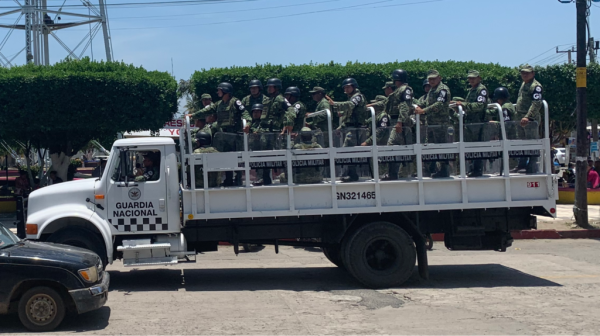By Maureen Meyer and Adam Isacson*

A truckload of military police, wearing National Guard armbands, passes through central Ciudad Hidalgo/ Adam Isacson, WOLA
Facing U.S. threats to impose potentially steep tariffs on Mexican goods last June, Mexico has adopted a series of measures along its southern border with Guatemala that, while somewhat effective at stopping the flow, seems a partial solution with high financial and political costs.
- Mexican authorities’ apprehensions of migrants in June, after U.S. President Donald Trump tweeted his threats, reached 31,416. Captures that month and in July were three times greater than the same period in 2018. (The total of migrants and asylum-seekers apprehended by the United States and Mexico last year is estimated to be more than a million.)
- Mexico deployed nearly 12,000 of its newly minted National Guard troops to the southern border states with Guatemala. Many identify themselves to visitors as “soldiers”; appear to have little (or no) specialized training for migrant interdiction; and wear military uniforms with black armbands that read “GN.” The Guard, however, has not reduced criminal activities against migrants. Local and international experts report that criminal elements assault, rob, rape and kidnap people transiting the area and prosecutors’ offices take little action to investigate these criminal attacks. Observers report that coyotes, working with corrupt officials, arrange safe passage for many migrants on designated “safe buses” for up to US$2,600 per person.
- Local observers say the enhanced operations have largely shut down what was the most transited of the four main routes through which migrants have traveled in recent times, but some people are learning to take alternate routes through puntos ciegos (blind spots) where government patrols don’t often go and where risks for migrants can be greater. One such corridor, in central Chiapas, seems to continue to be exploited robustly.
The Mexican government has been reluctant to deal with the consequences of its acquiescence to Washington’s demands, according to numerous border-area observers. At its peak, the aggressive patrolling filled detention centers to far over capacity (some at 300 percent capacity) with poor health conditions and alleged mistreatment. Apart from the members of the National Migration Institute’s Citizen Council, officials have restricted independent monitoring of detention facilities by human rights groups and migration specialists. The country’s refugee agency is on the verge of collapse, yet the Mexican government has yet to allocate sufficient resources to it. Over the course of 2019, the Mexican Commission for Refugee Assistance (COMAR) received over 70,000 asylum requests – more than double in 2018 – but its 2020 budget is a mere US$2.35 million (4 percent of UNHCR’s budget for Mexico operations).
- The U.S. push has put the administration of President Andrés Manuel López Obrador (AMLO) in a bind. On his first day in office, he signed a decree with Guatemala, Honduras, and El Salvador – from which the vast majority of migrants come – to address the underlying causes of the migration. Another agreement was reached with El Salvador, to fund programs to preserve and create jobs in agriculture. While the Mexican government has not left behind the focus on reducing the “push” factors of migration, it has been largely put on the back burner.
The Mexican government has put managing U.S. relations ahead of addressing the strategic migration problems it faces. It did not push back when the Trump administration announced it would be returning U.S.-bound asylum seekers to Mexico to wait for their hearings through the “Remain in Mexico” program, and under the threat of steadily rising tariffs up to 25 percent on Mexican goods, it has largely complied with nearly all U.S. demands. The results have been mixed, and the costs have been high.
- Sources in the southern border region report that the National Guard deployment and other Mexican actions over the past seven months have reduced – although estimates range from “not very significantly” to “probably just around 30 percent” – the number of Central American migrants arriving in Mexico. Shelters are not as full as they were in mid-2019, but several remain very full. Data on other nationalities is sketchy, but anecdotal information indicates that Cubans, Haitians, and even Africans continue to find their way to shelters in the area.
- In complying with U.S. demands, AMLO and his government have risked violating some of their fundamental stated values. AMLO had campaigned on independence, transparency and improved human rights, but the border deployments of the National Guard represent a further militarization of Mexico’s border security strategy – with a significant risk of human rights violations – and the detention of fearful Central Americans and extra-continental migrants in substandard conditions.
January 17, 2020
* Maureen Meyer is Director for Mexico and Migrant Rights at the Washington Office on Latin America (WOLA), and Adam Isacson is WOLA’s Director for Defense Oversight. The full text of their report is at The “Wall” Before the Wall: Mexico’s Crackdown on Migration at its Southern Border.”
